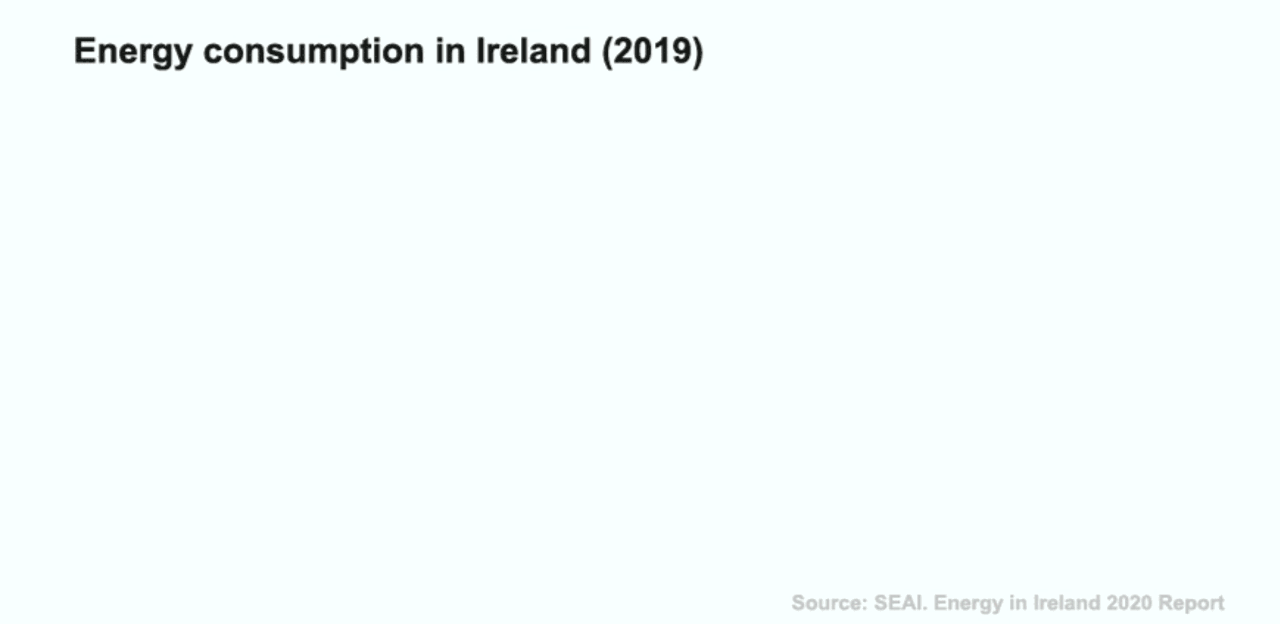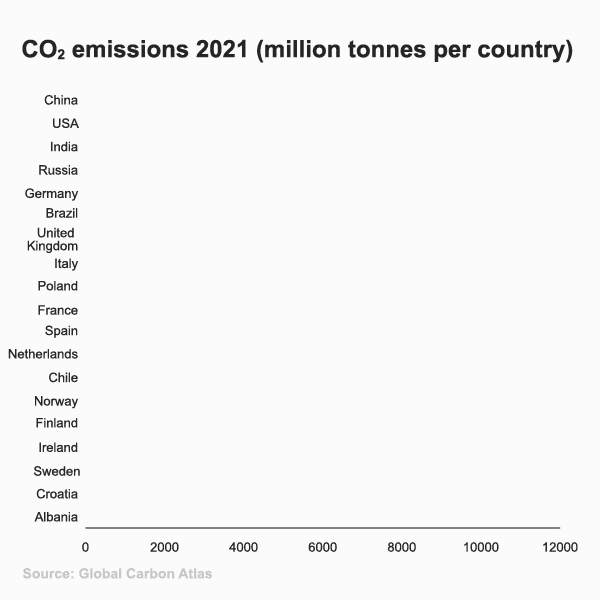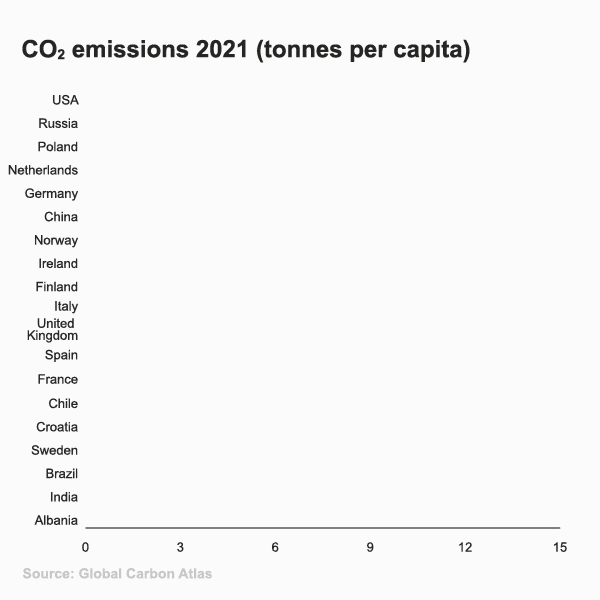
So far, only a small portion of Ireland's total energy needs is covered by renewable sources – primarily wind power.
Country series: Ireland with an ambitious climate action plan
About 40 per cent of Ireland's electricity currently comes from renewable sources, but the country aims to increase this to 70 per cent by 2030.
"Statkraft is heavily involved in the development of renewable energy in Ireland, including onshore wind and solar, offshore wind, and power grid solutions. All of this contributes to decarbonising Ireland's electricity generation system," says Kevin O'Donovan, Managing Director of Statkraft Ireland.

Effects of the financial crisis
Ireland is currently one of the countries in Europe that is furthest away from meeting its targets for climate emissions. It has higher emissions per capita than most other European countries. There are several reasons for this: Ireland was severely impacted by the financial crisis of 2008–2009, and in the following years jobs and economic growth were prioritised over climate action. The country has succeeded in recovering from the financial crisis, but its economic growth has led to increased use of fossil energy, especially in transport and heating.
In addition, Ireland has a large agricultural sector with an enormous production of meat and milk. While Irish agricultural products have one of the lowest carbon costs per kilogram, the sheer volume of agricultural production means that 30 per cent of greenhouse gas emissions in Ireland comes from agriculture. The EU average is 11 per cent.
Fossil challenges
Ireland has so far invested relatively little on renewable energy, and is only just setting out on the path of electrification of other sectors than the energy sector. Currently only 10 per cent of the country's energy needs is covered by renewable sources – primarily wind – while 90 per cent comes from oil, gas and peat.
Ireland has, however, committed itself to a fairly demanding green shift in the economy in general and in the energy sector in particular. In 2015, Irish authorities presented a plan for Ireland's low-carbon future. The Government committed to reduce emissions from the energy sector by 80–95 per cent by 2050 compared to 1990 levels.
In a report from 2019, the International Energy Agency (IEA) questioned how realistic these targets were – partly because Ireland had not managed to reduce emissions as previously planned and partly because the country was not on track to meet its targets for 2020 or 2030. According to the IEA, Ireland has the highest consumption of fossil energy for heating among all its member countries.
The use of peat and coal to produce energy is particularly harmful. In 2017, coal and peat produced 49 per cent of the carbon emissions from electricity production but generated only 19 per cent of the electricity. But Ireland plans to cut its use of peat and coal sharply by 2025, which will encourage the use of other sources of energy.
"Harvesting peat for energy production has been practised in Ireland for generations, so a transition away from this source of electricity production will pose many challenges for rural areas," says O'Donovan.
"However, we believe that local energy production from wind and solar can boost jobs and the economy and help local communities in these areas to survive," he says.



Kevin O'Donovan
Kevin O’Donovan is a Senior Vice President at Statkraft and Managing Director of UK and Ireland. As part of Statkraft's business area Europe, he is responsible for wind, solar, battery and grid services activities across both countries.



Statkraft is involved in several wind farms in Ireland. The picture was taken during the construction of a wind turbine in 2016.
Facts about Ireland
- Population: 4.9 million
- Capital: Dublin
- Government: Republic
- President: Michael D. Higgins
- Prime Minister: Micheál Martin
- Language: Irish and English
Climate action plan
In May 2019 the Irish government declared a climate emergency and shortly after submitted its Climate Action Plan 2019 on how Ireland will meet its climate targets.
"A fundamental requirement of this plan is to have 70 per cent of electricity generated from renewable sources by 2030. To achieve this, Ireland must achieve extensive electrification and produce the majority of its electricity from renewable sources," says O'Donovan.
This means that the power grid will need to be adapted and developed to handle higher levels of production from renewable sources, a reduction in the use of oil heating in private homes and a substantial growth in the number of electric vehicles. New buildings will face more stringent energy requirements, and grants will be provided for upgrading many existing homes. The plan also includes a target that 100 per cent of all new vehicles must be emission-free by 2030.
Although total energy production is still currently dominated by fossil fuels, the proportion of renewable sources in electricity production has increased in recent years. About 30 per cent of electricity production is now renewable (2017), and that share may approach 40 per cent already in 2020. Government agencies such as the power grid operator Eirgrid have accepted the challenge of 70 per cent renewable share by 2030 and are working to meet this target.

Growing market
Despite the fact that Ireland's electricity system began with the development of the Ardnachrusa hydropower plant in 1929, renewable energy in Ireland now comes almost exclusively from wind power.
"Thanks to its location facing the Atlantic Ocean, Ireland has excellent access to wind energy. Statkraft is ideally positioned to play an important role in Ireland's transition to renewable energy sources," says Kevin O'Donovan.
Statkraft Ireland is involved in the development, construction and operation of a significant number of onshore wind farms as well as solar and offshore wind energy projects. Ireland is one of the growth markets for Statkraft's investment in renewable energy, and within one year of its entry into the Irish market, the company celebrated the significant milestone of completing the construction of all seven turbines at the Kilathmoy wind farm in Limerick in the southwest of Ireland. This wind farm is expected to begin commercial operation in February 2020.
Statkraft has already received approval for the development of 130 MW of onshore wind energy projects in Ireland. The company has also secured approval to develop solar energy projects with a total capacity of 245 MW. These will provide renewable electricity to over 260 000 Irish households.
An additional 300 MW of onshore wind power is in the planning stage, along with the ongoing development of the 500 MW NISA (North Irish Sea Array) an offshore wind farm in the Irish Sea. All in all, Statkraft is on the way with renewable electricity for almost 820 000 Irish households.

Need for batteries
If 70 per cent of Ireland's electricity is to come from renewable sources, storage capacity will be needed to balance short-term variation in supply and demand. With ever-decreasing prices for LI-ion batteries, large battery systems are the current solution.
"Statkraft has significant experience in building and operating battery installations, and that helps manage the inevitable fluctuations that occur in the energy market. Statkraft also operates one of the world's largest virtual power plants and is ideally positioned to manage flexible power resources using its advanced algorithmic trading infrastructure in real time," says O'Donovan.
Statkraft has already developed its first battery storage facility in Ireland in conjunction with the development of the Kilathmoy wind farm. This plant will form an essential part of the Irish power grid in the future.
"Statkraft is playing a leading role in Ireland's transition to a low carbon future. I believe that the company's broad experience and expertise will prove very valuable to Ireland over the coming years," says Kevin O'Donovan.
Sources:
"Energy Policies of IEA Countries: Ireland 2019 Review" (IEA 2019)
"Climate Action Plan" (Department of Communications, Climate Action & Environment, Ireland)

Thanks to its location facing the Atlantic Ocean, Ireland has excellent access to wind energy. Statkraft is ideally positioned to play an important role in Ireland's transition to renewable energy sources.
Statkraft Ireland
- Statkraft Ireland develops, owns and operates renewable power plants, and is also involved in power trading.
- Ireland is one of the growth markets for Statkraft's wind power development.
- Statkraft has already taken a leading role in Ireland's transition to a low-carbon future.
- Statkraft's experience and expertise will benefit the country for years to come.
- Statkraft Ireland is based in Cork and Tullamore, and has employees with many years' experience from Element Power, the company Statkraft acquired in 2018.
Other country series articles

Country series: German energy revolution
2017 marked the first year when more power was produced from renewable sources than from coal in the industrial giant Germany. Nuclear power and coal power will be phased out over the next few years,...
Read more

Country series: Sweden global leader in reducing climate impact
Few countries in the world use more energy per capita than Sweden. Nevertheless, its greenhouse gas emissions are low, thanks to renewables generating a large part of the power consumed. The homeland...
Read more

Country series: Albania's hydropower important for the Balkans
Albania can play a key role when the Balkan countries phase out fossil fuels in favour of renewables. Statkraft already operates in Albania, but political risk can put a damper on further growth.
Read more

Country series: Ireland with an ambitious climate action plan
About 40 per cent of Ireland's electricity currently comes from renewable sources, but the country aims to increase this to 70 per cent by 2030.
Read more

Country series: Green ambitions in Spain
Renewable sources accounted for almost 47 per cent of the electricity produced in Spain in 2021. This is the highest share of renewable electricity since measurements began, but short of the Spanish...
Read more

Country series: Resource wealth in Brazil
Brazil is blessed with a wealth of natural resources and one of the world's cleanest power supplies. Large-scale investment in solar and wind power will provide even more renewable power in the years...
Read more

Country series: Ireland with an ambitious climate action plan
About 40 per cent of Ireland's electricity currently comes from renewable sources, but the country aims to increase this to 70 per cent by 2030.
Read more

Country series: United Kingdom, a leader in ambition
The United Kingdom has major ambitions for cutting its greenhouse gas emissions. The goal is to become a zero-emission society by 2050. Getting there will be a taxing process and requires strong poli...
Read more

Country series: Faster progress on renewables in Italy?
With its long coastline, high mountains and sunny Mediterranean islands, Italy should be well placed to increase its production of renewable energy. The challenge is to link power production with co...
Read more

Country series: The United States is still a land of opportunity
Since Statkraft opened an office in the U.S. in 2015, the company's U.S. operations have revolved largely around trading in CO2 allowances and renewable energy certificates. Statkraft is now well posi...
Read more

Country series: Renewables grow fast in Poland
Poland is one of the largest countries in Europe both in terms of energy consumption and energy production, and coal is still the main energy source. At the same time, Poland has the fastest growing...
Read more

Country series: Green visions in France
Nuclear power nation France faces massive changes in the energy sector in the years to come. An ambitious commitment to wind and solar power is one of the measures that will ensure that the climate ...
Read more

Country series: Chile leads the way with commitment to renewable energy
Chile has ambitious climate targets: 70 per cent of the country's electricity will come from renewable sources by 2030, and the country will be carbon neutral by 2050.
Read more